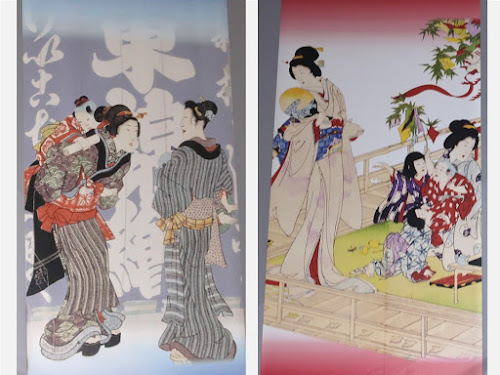First half of this month, they cultivate the
field. On the 23rd, Otoki gave birth to a son, while Okono had gave birth to a daughter in August. On the other hand, his father went out frequently; the 24-day
period from the 16th of this month to the 8th of next, he
went out for 16 days. He visited his relatives and friends. By the way, he was
banned from Edo (Tokyo) two years ago where much entertainment were,
because he spent a lot of money. He loved wondering about.
 |
| The field near Yoshino’s house、流山市芝崎の畑 |
月の前半は畑うなひ、23日におときが男子を生む。8月のおこのに続き、二人目の誕生だ。ところで、父は出歩く。二年前に江戸に行けなくなったせいか、畑うないが終わった9月16日から10月8日まで24日中、16日お出かけ。親戚や友達の訪問だ。
Meeting of the road improvement of Choufuku-ji temple、長福寺の道普請の会合
While key people of the village had held a lot of meetings already, they visited other villages from the 1st to the 3rd. In the evening on the 4th, the villagers held a general meeting and decided the donation to Choufuku-ji temple.On the 14th, perhaps the chief monk and his wife invited N. Nakamura and offered sake (alcohol) and soba-noodle. N. Nakamura worked hard for the road improvement and it went well, so the chief monk probably treated him . The road improvement was finally done in the late of next month.
先月から寄合があるが、1、2、3日と各村を廻ったりして打ち合わせ、4日の夜には「村中百姓集まる」とある。更に6日には、「村中の者集め、長福寺権化寄付取究(取り決め?)」とあるから寄付の件だろう。
14日、「弘誓山方丈御達、中村仲七を呼び、酒、蕎麦、振る舞う」とある。方丈御達(ごたち)は、住職とその夫人とも読め、長福寺の一件がまとまった祝いで、弘誓山は長福寺のことだろうか。中村仲七は長福寺の件で主とともに奔走していた。弘誓山の記述はつづき、26、27日は、「弘誓山権化寄進札書きに行く」とあり、寄進の記録を書きに行ったか。名主は、お寺の維持管理、道路などのインフラの維持管理で大忙しだ。
その後も寄合は続くが、翌月末に改修は行われたようだ。
On the 1st,
they cultivated the field.
On the 7th,
they cultivated the field, then they harvested particular rice to make mochi
rice cake.On the 8th, they also cultivated the field, then polished the rice.
On the 11th, Goma-fuda talisman of Narita-san was delivered to their house. Maybe someone went there and returned to the village.
On the 14th, they continued cultivating the field.
 |
Various fuda talismans @ Nerima Shakujiikoen Furusato
Museum 石神井公園ふるさと文化館
|
1日、畑うない。
7日、畑うなひ、餅刈揚(これは、もち米の収穫か)。8日、畑うなひ、餅搗(もち米を早速搗いたか)
11日、成田山の護摩札が来る。参詣した誰かが持って帰ったのだろうか。
14日、畑うなひが続く。
Aisuke was popular、愛輔はアイドル
On the 14th, Genzaburou came from Kashiwa, and returned with his mother and Aisuke. On the 19th, his father went to Kashiwa to see the festival with Aisuke and stayed there; it was three-day trip. His father went to Kashiwa often which is 10km away from their village.
14日、柏の名戸が谷の源三郎が来て、母は愛輔を連れて行く。19日は、父が愛輔を連れて、柏祭りに行き泊まる。父と愛輔は、21日の午前に帰宅する。二泊の小旅行だ。父も柏に頻繁に出かける。10kmは離れているけど。
 |
Children
in the Edo period at the entrance of Edo-Tokyo
Museum 江戸東京博物館
|
Fried rice、焼米
On the 16th, they cultivated as usual, then they gathered fried rice “Yaki-gome”. According the website “kotobank” (encyclopedia), it is a fried new unhulled rice. The rice hull is removed after frying. People eat it as snack, or sprinkle them on the soup and eat it like congee. The fried rice was brought to the lord by ship. Gonuemon was assigned and he got on a ship in the evening. He returned on the 18th with a thank-you letter of the lord. I am not sure it was delicious or precious, but I am sure the bond between the lord and villagers was very strong.
16日、畑うなひと共に、焼米集めと記載されている。焼米は、コトバンクによると、新米を籾のまま煎ってつき、殻を取り去ったもので、そのままスナック菓子として食べても良いし、汁物に浮かべて粥にして食べても良い。米の食べ方・保存法の一つ、というようなことが書かれている。平賀村からも焼米が届き、「夕、お屋敷、焼米両村より書状添え、今夜船にて出候。役権右衛門」ということで、夜船で焼米を領主に届けた。18日に、権右衛門は、御屋敷からご返書持ち来っている。わざわざ届けるほどの珍味だったのか、と思うが、領主とのつながりの強さを感じる。
From the
18th to 24th, his mother went to Shunzan-ji temple in
order to receive religious precepts. I wonder she became a Buddhist nun.
On the
22nd, they offered new mushroom to the lord which was a yearly event.
In the evening of the 23rd, Otoki gave birth safely to a baby boy. Congraturation!
On the 25th and 26th, they cultivated.
On the 26th, the master visited Gonemon and participated in the Benten-kou party, and stayed there. He was vigorous.
On the 27th, he went to Ne-gongen in Abiko which was a two-day trip. He was deeply religious. His mother also went there on the 22nd of August.
18日、母が春山寺に受戒に行くとあり、24日まで春山寺受戒、と続く。出家したのだろうか。
22日、御屋敷に初茸献上。例年の行事だ。23日夜、「おとき安産、男子誕生」とあり、めでたい、めでたい。
25、26日、畑うなひ。24日は母が春山寺の受戒から戻った日で、農事はなかったのかなあ。
27日、「夜、辨天講、宿権右衛門」ということで、主はお泊りをする。元気だ。
29日、主は一泊で我孫子の子権現に参詣に行く。随分信心深いと思う。8月22日には母が参詣している。
Treat the unacquainted travelers、旅の者の世話
Around 8 pm on the 27th when the master was out, travelers from Kanagawa-shuku (post-town, 50km away from Yoshino’s house) visited and asked to stay in his house. It was not accepted, but they offered meal to them. It was not a cold season, so I think sleeping outside was not difficult. His family were kind. By the way, his house was not near the arterial road. I wonder why travelers visited Yoshino; I think they were refused by other local people and finally arrived at the Yoshino’s house.On the 30th, they cultivated as usual.
 |
 |
Kanagawa
shuku 神奈川宿 @ Kanagawa Prefectural Museum of Cultural History (part1)、神奈川県立歴史博物館(1)
|
29日は。筑波山先達南宗院手代二人が来た後、夜20時ごろ、「神奈川宿の者が泊まりたいというが断り、食事のみ与える」とある。旧暦9月の野宿、大丈夫だが、食事をさせたのがやさしい。しかし、何で神奈川宿の人が、水戸街道から離れた芝崎に来るのか、断られ続けて芝崎に来たのだろうか。
30日、稲揚げに畑うない。
Previous
post: Yoshino’s daily life 21, August in 1851(嘉永4年8月)
Next
post: Yoshino’s
daily life 23, October in 1851(嘉永4年10月)Yoshino’s daily life 02, Life and fun of Yoshino family 吉野家の暮らしと楽しみ
Comments
Post a Comment